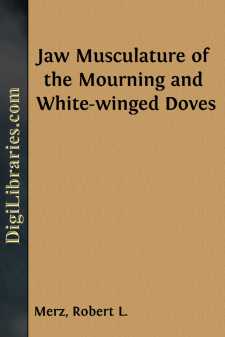Categories
- Antiques & Collectibles 13
- Architecture 36
- Art 48
- Bibles 22
- Biography & Autobiography 813
- Body, Mind & Spirit 142
- Business & Economics 28
- Children's Books 17
- Children's Fiction 14
- Computers 4
- Cooking 94
- Crafts & Hobbies 4
- Drama 346
- Education 46
- Family & Relationships 57
- Fiction 11829
- Games 19
- Gardening 17
- Health & Fitness 34
- History 1377
- House & Home 1
- Humor 147
- Juvenile Fiction 1873
- Juvenile Nonfiction 202
- Language Arts & Disciplines 88
- Law 16
- Literary Collections 686
- Literary Criticism 179
- Mathematics 13
- Medical 41
- Music 40
- Nature 179
- Non-Classifiable 1768
- Performing Arts 7
- Periodicals 1453
- Philosophy 64
- Photography 2
- Poetry 896
- Political Science 203
- Psychology 42
- Reference 154
- Religion 513
- Science 126
- Self-Help 84
- Social Science 81
- Sports & Recreation 34
- Study Aids 3
- Technology & Engineering 59
- Transportation 23
- Travel 463
- True Crime 29
Jaw Musculature of the Mourning and White-winged Doves
by: Robert L. Merz
Description:
Excerpt
MYOLOGY
The jaw musculature of doves is not an imposing system. The eating habits impose no considerable stress on the muscles; the mandibles are not used for crushing seeds, spearing, drilling, gaping, or probing as are the mandibles of many other kinds of birds. Doves use their mandibles to procure loose seeds and grains, which constitute the major part of their diet (Leopold, 1943; Kiel and Harris, 1956: 377; Knappen, 1938; Jackson, 1941), and to gather twigs for construction of nests. Both activities require but limited gripping action of mandibles. The crushing habit of a bird such as the Hawfinch (Coccothraustes coccothraustes), on the other hand, involves extremely powerful gripping (see, for example, Sims, 1955); the contrast is apparent in the development of the jaw musculature in the two types. Consequently, it is not surprising to find a relatively weak muscle mass in the jaw of doves, and because the musculature is weak there are few pronounced osseous fossae, cristae and tubercles. As a result, the bones, in addition to being small in absolute size, are relatively weaker when compared to skulls of birds having more distinctive feeding habits which require more powerful musculature.
The jaw muscles of the species dissected for this study are, in gross form, nearly identical from one species to another. Thus, a description of the pertinent myology of each species is unnecessary; one basic description is hereby furnished, with remarks on the variability observed between the species.
The terminology adopted by me for the jaw musculature is in boldfaced italic type. Synonyms are in italic type and are the names most often used by several other writers.
M. pterygoideus ventralis: part of Mm. pterygoidei, Gadow, 1891:323-325, table 26, figs. 1, 2, 3 and 4, and table 27, fig. 3—part of M. pterygoideus internus, Shufeldt, 1890:20, figs. 3, 5, 6, 7 and 11—part of M. adductor mandibulae internus, Edgeworth, 1935:58, figs. 605c and 607—part of M. pterygoideus anterior, Adams, 1919:101, pl. 8, figs. 2 and 3.
M. pterygoideus dorsalis: part of Mm. pterygoidei, Gadow, 1891:323-325, table 26, fig. 7 and table 27, figs. 1 and 3—part of M. pterygoideus internus, Shufeldt, 1890:20—part of M. adductor mandibulae internus, Edgeworth, 1935:58, fig. 605c—? part of M. pterygoideus anterior, Adams, 1919:101, pl. 8, figs. 2 and 3.
M. adductor mandibulae externus: a) pars superficialis: parts 1 and 2 of M. temporalis, Gadow, 1891:320-321—part of M. temporal, Shufeldt, 1890:16, figs. 5 and 7—part of M. adductor mandibulae externus, Edgeworth, 1935:58-60—M. capiti-mandibularis medius and profundus, Adams, 1919:101, pl. 8, fig. 1.
b) pars medialis: ? parts 1, 2 and 3 of M. temporalis, Gadow, 1891:320-322—part of M. masseter and ? part of M. temporal, Shufeldt, 1890:16-18, figs. 5, 6, 7 and 11—part of M. adductor mandibulae externus, Edgeworth, 1935:58-60—M. capiti-mandibularis superficialis, first part, Adams, 1919:100-101, pl. 8, fig. 1.
c) pars profundus: part 2 of M....


